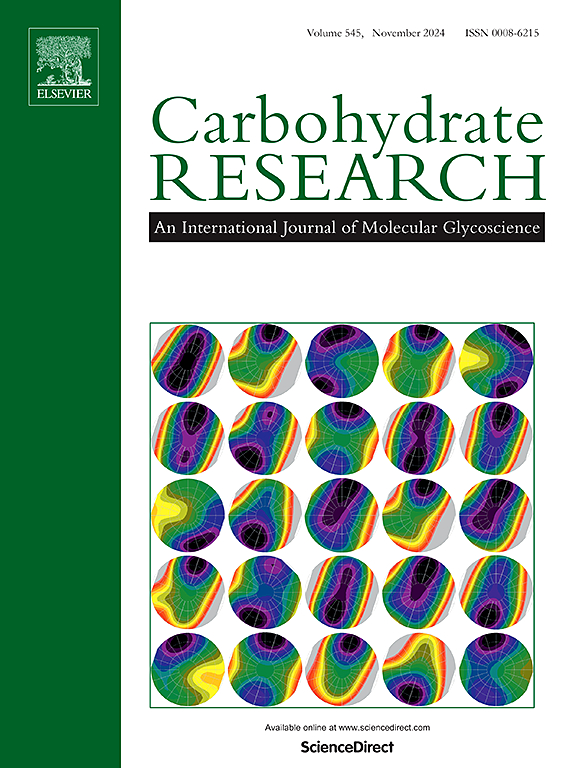Highly efficient esterification of waxy maize starch in choline chloride/acetic acid acidic deep eutectic solvent system
IF 2.4
3区 化学
Q3 BIOCHEMISTRY & MOLECULAR BIOLOGY
引用次数: 0
Abstract
In this study, to address the issue of solvent selection in the chemical modification of starch, a method was developed for the efficient esterification of waxy maize starch (WMS) using an acidic deep eutectic solvent composed of choline chloride and acetic acid (CCHAc-ADES). The impact of different mass fractions of CCHAc-ADES on the degree of substitution and reaction efficiency of lauric acid starch esters was explored. It was found that under the conditions of 70 wt% CCHAc-ADES, starch esters with the highest degree of substitution of 0.161 were successfully prepared, achieving an esterification efficiency of 79.63 %. 13C and 1H nuclear magnetic resonance spectroscopy, X-ray diffraction and gel permeation chromatography revealed that CCHAc-ADES acted within the surface voids of WMS particles without seriously damaging the WMS structure, making it a favorable solvent for chemical modification of WMS. By monitoring changes in the morphology, relative crystallinity, particle size, and hydrophobicity of esterified WMS in CCHAc-ADES, the formation mechanism of lauric acid starch esters was inferred, primarily related to the competitive hydrogen bonding of CCHAc-ADES with WMS. The method proposed in this study allows for the preparation of long-chain fatty acid starch esters without the use of any additional chemicals or enzymes, offering significant guidance for the application of deep eutectic solvents in green synthesis.

氯化胆碱/醋酸酸性深共熔溶剂体系中糯玉米淀粉的高效酯化反应。
为了解决淀粉化学改性中溶剂选择的问题,研究了一种采用氯化胆碱-乙酸(CCHAc-ADES)组成的酸性深共晶溶剂对糯玉米淀粉(WMS)进行高效酯化反应的方法。探讨了不同质量分数的CCHAc-ADES对月桂酸淀粉酯取代度和反应效率的影响。结果表明,在CCHAc-ADES质量分数为70%的条件下,成功制备了取代度最高为0.161的淀粉酯,酯化效率为79.63%。13C和1H核磁共振谱、x射线衍射和凝胶渗透色谱显示,CCHAc-ADES作用于WMS颗粒的表面空隙内,而不严重破坏WMS的结构,是对WMS进行化学改性的良好溶剂。通过监测酯化WMS在CCHAc-ADES中的形貌、相对结晶度、粒径和疏水性的变化,推测月桂酸淀粉酯的形成机制,主要与CCHAc-ADES与WMS的竞争氢键有关。本研究提出的方法可以制备长链脂肪酸淀粉酯,而不需要使用任何额外的化学物质或酶,为深共晶溶剂在绿色合成中的应用提供了重要的指导。
本文章由计算机程序翻译,如有差异,请以英文原文为准。
求助全文
约1分钟内获得全文
求助全文
来源期刊

Carbohydrate Research
化学-生化与分子生物学
CiteScore
5.00
自引率
3.20%
发文量
183
审稿时长
3.6 weeks
期刊介绍:
Carbohydrate Research publishes reports of original research in the following areas of carbohydrate science: action of enzymes, analytical chemistry, biochemistry (biosynthesis, degradation, structural and functional biochemistry, conformation, molecular recognition, enzyme mechanisms, carbohydrate-processing enzymes, including glycosidases and glycosyltransferases), chemical synthesis, isolation of natural products, physicochemical studies, reactions and their mechanisms, the study of structures and stereochemistry, and technological aspects.
Papers on polysaccharides should have a "molecular" component; that is a paper on new or modified polysaccharides should include structural information and characterization in addition to the usual studies of rheological properties and the like. A paper on a new, naturally occurring polysaccharide should include structural information, defining monosaccharide components and linkage sequence.
Papers devoted wholly or partly to X-ray crystallographic studies, or to computational aspects (molecular mechanics or molecular orbital calculations, simulations via molecular dynamics), will be considered if they meet certain criteria. For computational papers the requirements are that the methods used be specified in sufficient detail to permit replication of the results, and that the conclusions be shown to have relevance to experimental observations - the authors'' own data or data from the literature. Specific directions for the presentation of X-ray data are given below under Results and "discussion".
 求助内容:
求助内容: 应助结果提醒方式:
应助结果提醒方式:


